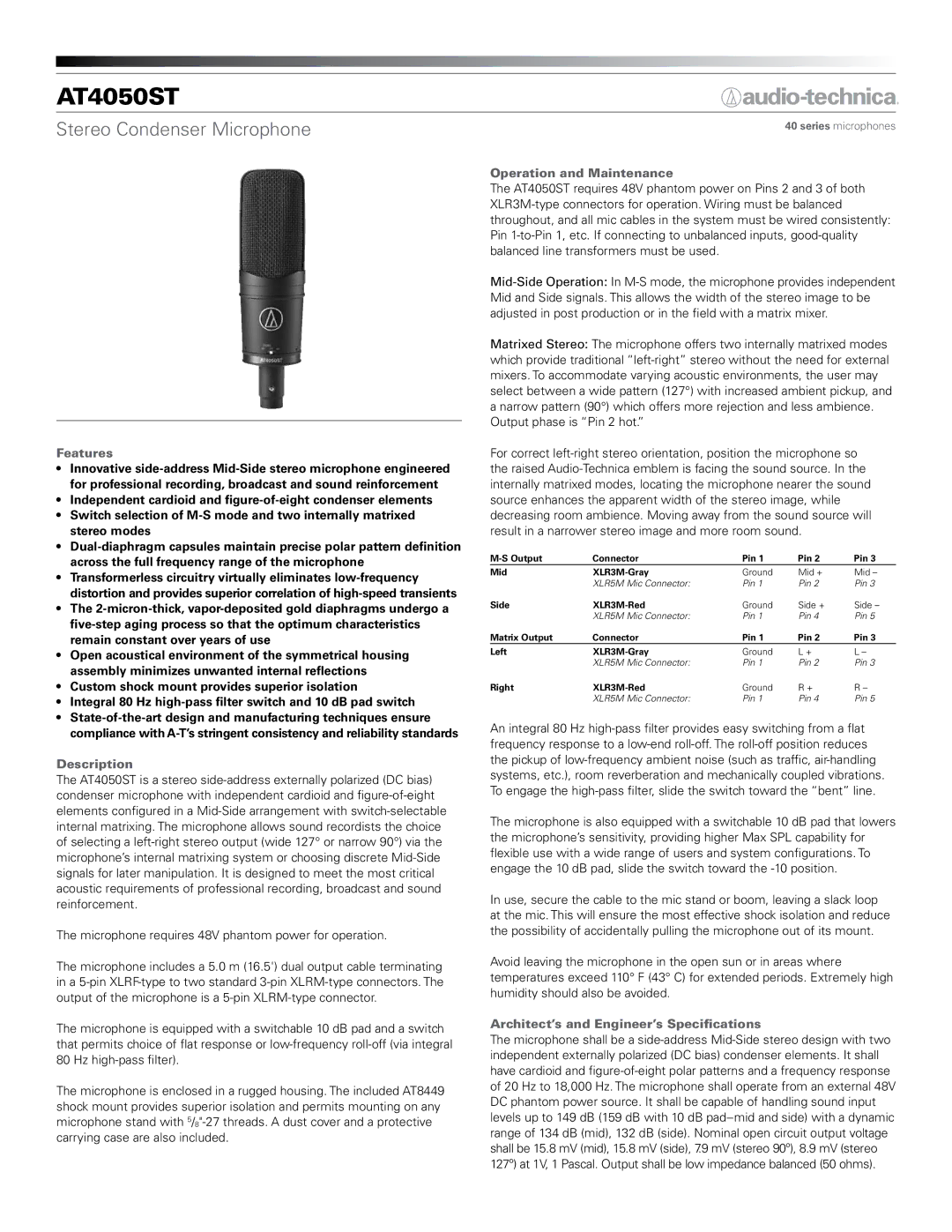Stereo Condenser Microphone
Features
•Innovative side-address Mid-Side stereo microphone engineered for professional recording, broadcast and sound reinforcement
•Independent cardioid and figure-of-eight condenser elements
•Switch selection of M-S mode and two internally matrixed stereo modes
•Dual-diaphragm capsules maintain precise polar pattern definition across the full frequency range of the microphone
•Transformerless circuitry virtually eliminates low-frequency distortion and provides superior correlation of high-speed transients
•The 2-micron-thick, vapor-deposited gold diaphragms undergo a five-step aging process so that the optimum characteristics remain constant over years of use
•Open acoustical environment of the symmetrical housing assembly minimizes unwanted internal reflections
•Custom shock mount provides superior isolation
•Integral 80 Hz high-pass filter switch and 10 dB pad switch
•State-of-the-art design and manufacturing techniques ensure compliance with A-T’s stringent consistency and reliability standards
Description
The AT4050ST is a stereo side-address externally polarized (DC bias) condenser microphone with independent cardioid and figure-of-eight elements configured in a Mid-Side arrangement with switch-selectable internal matrixing. The microphone allows sound recordists the choice of selecting a left-right stereo output (wide 127° or narrow 90°) via the microphone’s internal matrixing system or choosing discrete Mid-Side signals for later manipulation. It is designed to meet the most critical acoustic requirements of professional recording, broadcast and sound reinforcement.
The microphone requires 48V phantom power for operation.
The microphone includes a 5.0 m (16.5') dual output cable terminating in a 5-pin XLRF-type to two standard 3-pin XLRM-type connectors. The output of the microphone is a 5-pin XLRM-type connector.
The microphone is equipped with a switchable 10 dB pad and a switch that permits choice of flat response or low-frequency roll-off (via integral 80 Hz high-pass filter).
The microphone is enclosed in a rugged housing. The included AT8449 shock mount provides superior isolation and permits mounting on any microphone stand with 5/8"-27 threads. A dust cover and a protective carrying case are also included.
40 series microphones
Operation and Maintenance
The AT4050ST requires 48V phantom power on Pins 2 and 3 of both XLR3M-type connectors for operation. Wiring must be balanced throughout, and all mic cables in the system must be wired consistently: Pin 1-to-Pin 1, etc. If connecting to unbalanced inputs, good-quality balanced line transformers must be used.
Mid-Side Operation: In M-S mode, the microphone provides independent Mid and Side signals. This allows the width of the stereo image to be adjusted in post production or in the field with a matrix mixer.
Matrixed Stereo: The microphone offers two internally matrixed modes which provide traditional “left-right” stereo without the need for external mixers. To accommodate varying acoustic environments, the user may select between a wide pattern (127°) with increased ambient pickup, and a narrow pattern (90°) which offers more rejection and less ambience. Output phase is “Pin 2 hot.”
For correct left-right stereo orientation, position the microphone so the raised Audio-Technica emblem is facing the sound source. In the internally matrixed modes, locating the microphone nearer the sound source enhances the apparent width of the stereo image, while decreasing room ambience. Moving away from the sound source will result in a narrower stereo image and more room sound.
M-S Output | Connector | Pin 1 | Pin 2 | Pin 3 |
Mid | XLR3M-Gray | Ground | Mid + | Mid – |
| XLR5M Mic Connector: | Pin 1 | Pin 2 | Pin 3 |
Side | XLR3M-Red | Ground | Side + | Side – |
| XLR5M Mic Connector: | Pin 1 | Pin 4 | Pin 5 |
Matrix Output | Connector | Pin 1 | Pin 2 | Pin 3 |
Left | XLR3M-Gray | Ground | L + | L – |
| XLR5M Mic Connector: | Pin 1 | Pin 2 | Pin 3 |
Right | XLR3M-Red | Ground | R + | R – |
| XLR5M Mic Connector: | Pin 1 | Pin 4 | Pin 5 |
An integral 80 Hz high-pass filter provides easy switching from a flat frequency response to a low-end roll-off. The roll-off position reduces the pickup of low-frequency ambient noise (such as traffic, air-handling systems, etc.), room reverberation and mechanically coupled vibrations. To engage the high-pass filter, slide the switch toward the “bent” line.
The microphone is also equipped with a switchable 10 dB pad that lowers the microphone’s sensitivity, providing higher Max SPL capability for flexible use with a wide range of users and system configurations. To engage the 10 dB pad, slide the switch toward the -10 position.
In use, secure the cable to the mic stand or boom, leaving a slack loop at the mic. This will ensure the most effective shock isolation and reduce the possibility of accidentally pulling the microphone out of its mount.
Avoid leaving the microphone in the open sun or in areas where temperatures exceed 110° F (43° C) for extended periods. Extremely high humidity should also be avoided.
Architect’s and Engineer’s Specifications
The microphone shall be a side-address Mid-Side stereo design with two independent externally polarized (DC bias) condenser elements. It shall have cardioid and figure-of-eight polar patterns and a frequency response of 20 Hz to 18,000 Hz. The microphone shall operate from an external 48V DC phantom power source. It shall be capable of handling sound input levels up to 149 dB (159 dB with 10 dB pad–mid and side) with a dynamic range of 134 dB (mid), 132 dB (side). Nominal open circuit output voltage shall be 15.8 mV (mid), 15.8 mV (side), 7.9 mV (stereo 90º), 8.9 mV (stereo 127º) at 1V, 1 Pascal. Output shall be low impedance balanced (50 ohms).

